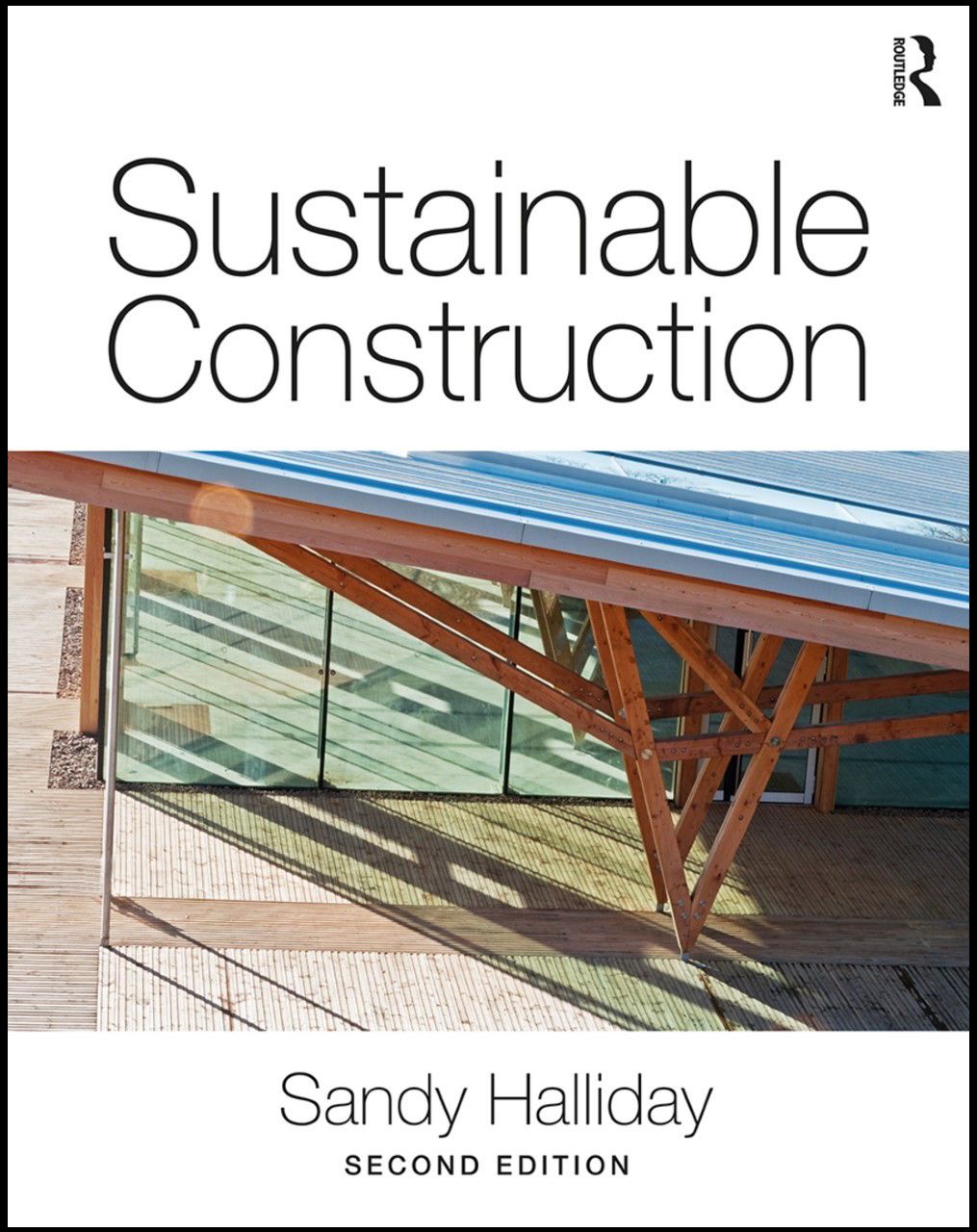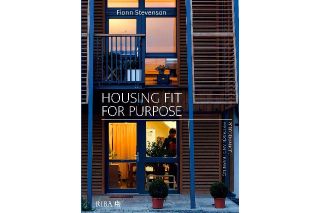
www.buildingsandcities.org/insights/reviews/sustainable-construction-second-eddition-sandy-halliday.html
Sustainable Construction, Second Edition
By Sandy Halliday. Routledge, 2019, ISBN: 9781138200289

Building scientist, troubleshooter and policy advisor Bill Bordass reviews the second edition of this book. It is substantially rewritten and even better than the first edition, which was itself derived from a series of teaching modules.
This is a very good book, intelligent in
outlook, broad in scope, well-structured, well-illustrated and inspirational.
Perhaps uniquely, it is also highly readable and will appeal to a wide
audience: from experts and professionals to students and non-specialists -
perhaps someone wondering what to do to improve the sustainability of their
house or workplace, or a policymaker seeking to be better-informed on a subject
that is at last appearing in mainstream debate. This is a remarkable
achievement. Although there are many other books on sustainable built
environment, this one provides a consistent, wide-ranging and insightful
approach.
This new edition has more pages, fewer
sections and more illustrations. 120 short case studies (of buildings,
procedures, studies, results etc.) from around the world are interspersed with
the text, enlivening the presentation and triggering the imagination. I only
wish the publishers had changed the title: it is about so much more than
construction and should be found at the front of the bookshop, not to special
order, or in a remote technical backwater.
Of its twelve Sections, the first four are on background issues: Drivers (a history of ideas on the subject over the past half-century, illustrated by iconic early projects), Policy and Legislation (including some local policies that can be thought-provoking, e.g. why isn't everybody doing this?), Cost Issues (not a dreary succession of tables but a thoughtful discussion of cost, investment, value in the broadest sense, and doing more with less), and Appraisal Methods. The next six cover technical aspects: Materials Selection, Low-impact Construction, Internal Environmental Control (with fabric coming first of course), Energy Generation, Lighting and Daylighting, and Water and Sewage Management. Then comes Construction Processes (which stresses the importance of briefing, consultation, questioning assumptions, and continuity in maintaining initial aspirations), and a concluding section on Urban Ecology, reaching outside buildings themselves.
The book has the great advantage of being
written by a single person with great knowledge, long experience, clear
insights and a sense of purpose: not inconsistently cobbled together from
different chapter authors, as too often happens with books of such a wide scope.
It is not just a technical manual: the author hopes it will help move
sustainable construction to the heart and soul of economic and social policy
and contribute to health, well-being and life chances.
As an assessor of building performance in
use, this reviewer would like to have seen a few longer case studies - but perhaps
these are better left to others on the web, as the information can date quite
rapidly. Some case studies could also have been more critical, particularly for
projects for which good in-use performance histories are available. Getting any
building to work in accordance with its design intent is difficult: most never
do, owing to the lack of a chain of custody that connects from client and
design intent to operational reality. The need for this "golden thread" was also
pointed out in the recent report (Hackitt,
2019) into the horrific fire at Grenfell Tower in London - where ill-considered
alterations to improve thermal performance appear to have been a major
contributor. As at Grenfell, many building projects lack sufficient attention
to detail; and seldom receive much aftercare and fine tuning in the months or
even years after handover. The results also include the now-notorious
"performance gaps" between energy performance claims and actual outcomes. Other
aspects can also fall short, including occupant satisfaction, health and
comfort.
An example of one kind of discrepancy is
what happened with Oberlin College's Adam Joseph Lewis Centre (completed
in 2001). Its spacesused about three times the predicted amount of energy, far exceeding
the annual supply from the 60 kWp rooftop photovoltaic panels that were
intended to make it a nett energy exporter. This dramatically increased its primary
energy and carbon footprint, as the low-energy expectations had meant it was all-electric.
Five years later, with 101 kWp of photovoltaic panels added over the car park,
its annual electricity use still exceeded the PV supply. This situation was only
remedied in 2012 - eleven years after completion - when the College appointed a
building manager who initially worked full-time on solving the building's performance
problems (Janda
& Topouzi, 2015). During the whole time, its performance was
scrutinised by Oberlin's academics - who initially disagreed radically about
assessment methods, which greatly affected any conclusions about its sustainability.
This all provided a valuable learning experience.
Insights such as this would have added further
depth to the arguments in the book. Buildings with sustainable design intent
and a skilled team can be intrinsically more robust than ordinary ones: more
future-proof and less dependent on consumables, technology, management and
maintenance. However, the job of creating a well-integrated and well-performing
building is exacting, as there tend to be more interdependencies between people,
skills, elements, systems, technologies and management; and routine tune-ups
after completion seldom happen. I liken it to a staircase: if not all the steps
are in place, you won't end up where you want to be.
Modern procurement systems often don't help
either, salami-slicing the "golden thread" from client and design intent to
practical reality: the author likens this to a relay race in which the baton is
not passed over. We need radical change in client, industry and government practices;
true professionals across design and building teams who take full account of
"the other" in their work and follow their projects through after handover; and
an industry that pays attention to detail and is driven by achieving good
performance in reality, not just in theory.
A good read end-to-end, this book has a clear structure and a good index, and can be dipped into at any point. Recently, I was pleased to see an already well-thumbed copy in the studio of one of those few architecture schools that make sustainability central to their curriculum. Other departments - not just architectural - now have no excuse not to follow suit: this important book should become a standard text for all built environment students and practitioners. If it also receives the broader attention it deserves, it will have achieved the author's ambition to put a thoughtful approach to sustainable buildings and environments into mainstream economic and social thinking. For anybody not yet convinced, an informative four-minute introductory video by the author is here: www.youtube.com/watch?v=pMJtLb4nDUU .
References
Hackitt, J. (May 2019) Building a safer future, Independent Review of Building Regulations and Fire Safety: Final Report, London: HMSO, chapter 8. https://www.gov.uk/government/publications/independent-review-of-building-regulations-and-fire-safety-final-report
Janda, K. & Topouzi, M. (2015) Telling tales: using stories to remake energy policy, Building Research & Information, 43:4, 516-533, page 521 et seq. https://www.tandfonline.com/doi/full/10.1080/09613218.2015.1020217
Latest Peer-Reviewed Journal Content
Designing for pro-environmental behaviour change: the aspiration–reality gap
J Simpson & J Uttley
Lifetimes of demolished buildings in US and European cities
J Berglund-Brown, I Dobie, J Hewitt, C De Wolf & J Ochsendorf
Expanding the framework of urban living labs using grassroots methods
T Ahmed, I Delsante & L Migliavacca
Youth engagement in urban living labs: tools, methods and pedagogies
N Charalambous, C Panayi, C Mady, T Augustinčić & D Berc
Co-creating urban transformation: a stakeholder analysis for Germany’s heat transition
P Heger, C Bieber, M Hendawy & A Shooshtari
Placemaking living lab: creating resilient social and spatial infrastructures
M Dodd, N Madabhushi & R Lees
Church pipe organs: historical tuning records as indoor environmental evidence
B Bingley, A Knight & Y Xing
A framework for 1.5°C-aligned GHG budgets in architecture
G Betti, I Spaar, D Bachmann, A Jerosch-Herold, E Kühner, R Yang, K Avhad & S Sinning
Net zero retrofit of the building stock [editorial]
D Godoy-Shimizu & P Steadman
Co-learning in living labs: nurturing civic agency and resilience
A Belfield
The importance of multi-roles and code-switching in living labs
H Noller & A Tarik
Researchers’ shifting roles in living labs for knowledge co-production
C-C Dobre & G Faldi
Increasing civic resilience in urban living labs: city authorities’ roles
E Alatalo, M Laine & M Kyrönviita
Co-curation as civic practice in community engagement
Z Li, M Sunikka-Blank, R Purohit & F Samuel
Preserving buildings: emission reductions from circular economy strategies in Austria
N Alaux, V Kulmer, J Vogel & A Passer
Urban living labs: relationality between institutions and local circularity
P Palo, M Adelfio, J Lundin & E Brandão
Living labs: epistemic modelling, temporariness and land value
J Clossick, T Khonsari & U Steven
Co-creating interventions to prevent mosquito-borne disease transmission in hospitals
O Sloan Wood, E Lupenza, D M Agnello, J B Knudsen, M Msellem, K L Schiøler & F Saleh
Circularity at the neighbourhood scale: co-creative living lab lessons
J Honsa, A Versele, T Van de Kerckhove & C Piccardo
Positive energy districts and energy communities: how living labs create value
E Malakhatka, O Shafqat, A Sandoff & L Thuvander
Built environment governance and professionalism: the end of laissez-faire (again)
S Foxell
Co-creating justice in housing energy transitions through energy living labs
D Ricci, C Leiwakabessy, S van Wieringen, P de Koning & T Konstantinou
HVAC characterisation of existing Canadian buildings for decarbonisation retrofit identification
J Adebisi & J J McArthur
Simulation and the building performance gap [editorial]
M Donn
Developing criteria for effective building-sector commitments in nationally determined contributions
P Graham, K McFarlane & M Taheri
Join Our Community

The most important part of any journal is our people – readers, authors, reviewers, editorial board members and editors. You are cordially invited to join our community by joining our mailing list. We send out occasional emails about the journal – calls for papers, special issues, events and more.
We will not share your email with third parties. Read more



Latest Commentaries
COP30 Report
Matti Kuittinen (Aalto University) reflects on his experience of attending the 2025 UN Conference of the Parties in Belém, Brazil. The roadmaps and commitments failed to deliver the objectives of the 2025 Paris Agreement. However, 2 countries - Japan and Senegal - announced they are creating roadmaps to decarbonise their buildings. An international group of government ministers put housing on the agenda - specifying the need for reduced carbon and energy use along with affordability, quality and climate resilience.
Building-Related Research: New Context, New Challenges
Raymond J. Cole (University of British Columbia) reflects on the key challenges raised in the 34 commissioned essays for Buildings & Cities 5th anniversary. Not only are key research issues identified, but the consequences of changing contexts for conducting research and tailoring its influence on society are highlighted as key areas of action.